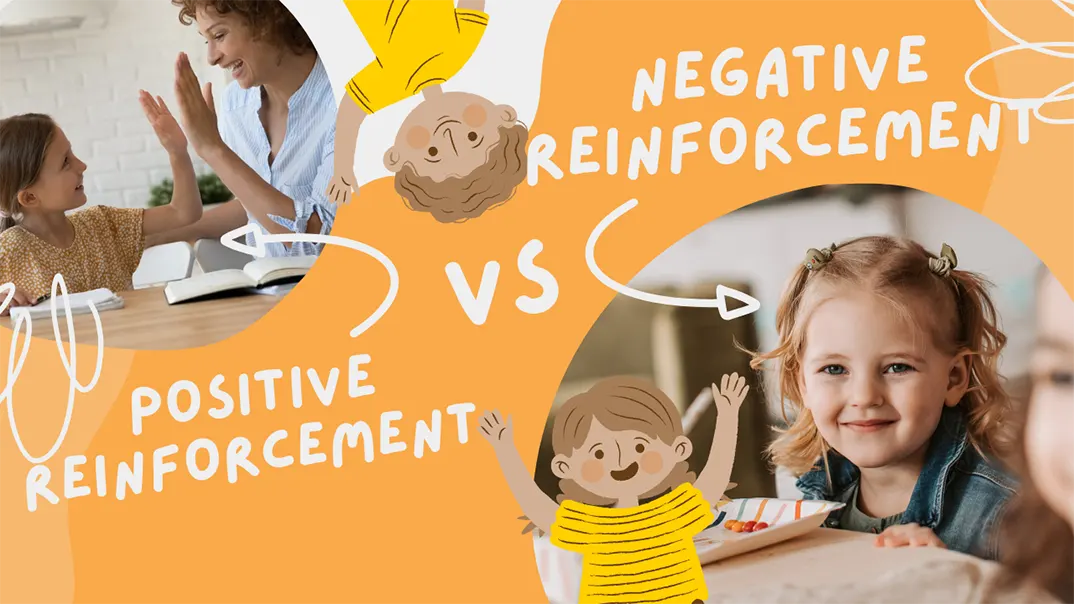As a parent or teacher, have you ever struggled to decide between praise and discipline when managing a child’s behavior? Should you reward a child for good behavior or remove privileges for misbehavior? The debate around positive reinforcement vs negative reinforcement can be confusing, especially when the goal is to guide children in a consistent, effective, and nurturing manner. When to use positive reinforcement and negative reinforcement can feel overwhelming without clear guidance.
To clear up the confusion around positive reinforcement vs negative reinforcement, it’s essential to understand that both are behavior management tools rooted in behavioral psychology. Positive reinforcement involves adding a rewarding stimulus after a desired behavior to increase the likelihood of that behavior repeating. In contrast, negative reinforcement means removing an unpleasant stimulus to encourage the desired behavior. Both methods aim to strengthen behaviors, but they work through different mechanisms.
So, if you’re eager to manage challenging behaviors, motivate your child or student effectively, and build a more respectful and responsive relationship, keep reading. This guide will equip you with the knowledge and tools to apply positive reinforcement vs negative reinforcement in everyday scenarios confidently.
Basics of Operant Conditioning
To understand the difference between positive reinforcement and negative reinforcement, it’s important to first understand the foundation they both come from: Operant Conditioning.

Operant conditioning is a theory of learning developed by psychologist B.F. Skinner. It explains how behaviors are shaped and maintained by their consequences. According to this theory, behaviors followed by favorable outcomes are more likely to be repeated, while those followed by unfavorable outcomes are less likely to occur again.
There are four types of operant conditioning:
- Positive Reinforcement: Adding a pleasant stimulus to increase a behavior.
Example: Giving a child a sticker for cleaning up their toys. - Negative Reinforcement: Removing an unpleasant stimulus to increase a behavior.
Example: Turning off a noisy alarm once a child wakes up on time. - Positive Punishment: Adding an unpleasant stimulus to decrease a behavior.
Example: Giving extra chores for breaking a rule. - Negative Punishment: Removing a pleasant stimulus to decrease a behavior.
Example: Taking away playtime for not following instructions.
What Is Positive Reinforcement
Positive reinforcement is a strategy used to increase the likelihood of a desired behavior by offering a rewarding outcome immediately after the behavior occurs. In practical terms, this could be as simple as praising a child for saying “please” or giving a sticker when homework is completed on time. The underlying principle is to associate positive outcomes with specific behaviors, which encourages children to repeat those actions.
Unlike punishment, which focuses on reducing unwanted behavior, positive reinforcement motivates children by making them feel good about what they did right. This concept is central when comparing positive reinforcement vs negative reinforcement, as both are designed to promote behavior, but positive reinforcement does so by adding something rewarding, rather than taking something unpleasant away.
Types of Positive Reinforcement
The effectiveness of positive reinforcement depends on what the child values and how the reinforcement is delivered. Here are the five main types:
- Social Reinforcement
This involves verbal praise, smiles, nods, high-fives, or hugs. It’s one of the most commonly used and powerful forms, especially in early childhood settings. A simple “Great job!” can go a long way in reinforcing good behavior. - Natural Reinforcement
Occurs naturally as a direct consequence of the behavior. For instance, a child who finishes their homework early gets more time to play. These reinforcements are embedded in daily life and are often the most sustainable over time. - Tangible Reinforcement
Involves physical rewards like العاب تعليمية, stickers, treats, or certificates. While effective in the short term, overreliance can lead to a “What do I get?” mindset, so it’s best used sparingly and paired with other forms. - Token Reinforcement
Children earn tokens, points, or stars for positive behaviors, which can later be exchanged for a larger reward. This system helps teach delayed gratification and is especially useful in classroom management or behavior intervention plans. - Activity-Based Reinforcement
This type allows the child to engage in a preferred activity after completing a desired behavior, like getting extra computer time after finishing chores or being allowed to choose a story after helping clean up.
How to Implement Positive Reinforcement?
Implementing positive reinforcement effectively is both an art and a science. It’s not just about handing out rewards—it’s about creating meaningful connections between behavior and consequence, fostering intrinsic motivation, and building respectful relationships with children. When done correctly, positive reinforcement becomes a powerful tool in shaping behavior.

Identify the Desired Behavior
Begin by clearly defining what behavior you want to reinforce. Is it sharing toys, completing homework, using polite language, or following قواعد الفصل الدراسي? The more specific you are, the easier it will be for the child to understand and meet your expectations.
Choose Meaningful Reinforcers
Not all children respond to the same rewards. Observe and ask what motivates your child or student. It could be verbal praise, extra screen time, a special activity, or even a small treat. Reinforcers should be age-appropriate and aligned with the child’s interests.
Deliver Reinforcement Immediately
Timing is critical. For the reinforcement to be effective, it must be delivered right after the desired behavior occurs. This immediate connection helps the child understand what action led to the positive outcome.
Be Consistent and Specific
Use reinforcement consistently and describe exactly what the child did right. Instead of saying, “Good job,” say, “I really liked how you helped your friend clean up without being asked.” This not only reinforces the behavior but also teaches what’s expected.
Gradually Shift to Natural Reinforcement
As the behavior becomes more consistent, begin to fade out tangible rewards and rely more on social or natural reinforcers like praise, responsibility, or privileges. This helps avoid dependency on external rewards and encourages internal motivation.
Monitor and Adjust
Keep track of how the child responds to different types of reinforcement. If a particular strategy stops working, be flexible and try another. Children’s needs and motivations change, so your approach should too.
What Is Negative Reinforcement
Negative reinforcement strengthens a behavior by taking something unpleasant away when the behavior happens. Despite its name, negative reinforcement is not the same as punishment. It is a method of encouraging good behavior, not discouraging bad behavior. For example, a teacher may stop scolding a student once they begin paying attention in class. Or a parent might stop nagging a child once they start cleaning their room. The behavior is reinforced because it results in the removal of something undesirable.
Types of Negative Reinforcement
In early childhood settings, negative reinforcement most often takes two forms: escape learning and avoidance learning. While both increase a desired behavior by removing or preventing something unpleasant, they differ in timing and purpose. Understanding this distinction helps parents and teachers apply these strategies with greater intention and care.
Escape Learning
Escape learning occurs when a child learns to perform a behavior to stop or reduce an unpleasant experience that is already happening.
Definition:
The child is already exposed to an aversive stimulus and learns a behavior that helps them escape it.
Examples:
- A preschooler begins to cry during a loud group song. The teacher allows them to move to a quieter space. Next time, the child may cry again to escape loud environments.
- A child feels frustrated by a complex puzzle. When they express distress, the activity is removed. They are more likely to react with distress in similar future tasks.
Application Tip:
Escape learning should be used cautiously. While it can support emotional relief, it should also be paired with skill-building (e.g., coping strategies or problem-solving) to avoid reinforcing avoidance through distress signals.
Avoidance Learning
Avoidance learning happens when a child performs a behavior to prevent an unpleasant experience from occurring in the first place.
Definition:
The behavior occurs before the aversive stimulus starts and helps the child avoid it entirely.
Examples:
- A child cleans up their toys right after playtime ends to avoid repeated reminders from the teacher.
- A student sits quietly during circle time to avoid losing their “line leader” privilege.
Application Tip:
Avoidance learning can be useful for teaching responsibility and encouraging proactive behaviors. The key is to ensure that children understand the cause-and-effect link and are not acting out of fear, but rather out of awareness and self-management.
How to Implement Negative Reinforcement
While often misunderstood, negative reinforcement can be a powerful behavioral strategy when used correctly and ethically. The key is to remember that negative reinforcement is not about punishment—it’s about removing an unpleasant condition to encourage a specific behavior. When implemented with care, it can motivate children to make better choices and develop responsibility.
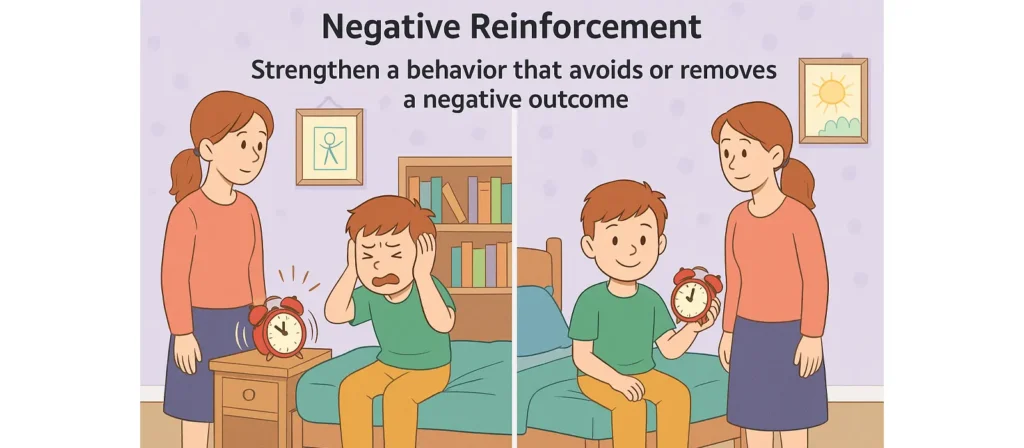
Clearly Define the Undesirable Condition
Start by identifying the unpleasant stimulus that will be removed. This could be something like a noisy timer, a repetitive reminder, or a mild but irritating task. The child should be aware that this stimulus is linked to a specific behavior and can be controlled by their actions.
Link Behavior with Relief
The child must understand the connection between their behavior and the removal of the aversive element. For example, if a student is given additional homework for not participating but can have it removed by raising their hand and contributing, that’s negative reinforcement in action.
Use Mild, Non-Punitive Conditions
Avoid using threats or harsh consequences as an unpleasant stimulus. The goal is to apply just enough discomfort to encourage the behavior, not to instill fear or anxiety. Common examples include ending nagging when chores are done or stopping a repetitive instruction once a child complies.
Be Immediate and Consistent
Just like with positive reinforcement, timing matters. As soon as the desired behavior is shown, remove the aversive condition. This strengthens the behavior-consequence link in the child’s mind. Consistency across situations also helps children recognize patterns and learn faster.
Avoid Reinforcing Avoidance Behaviors
It’s important to monitor that the child is not using avoidance strategies to escape responsibility. For example, if a child throws tantrums to get out of doing homework and the task is removed, that’s reinforcing the wrong behavior. Make sure that the unpleasant condition is only removed after the child demonstrates the expected behavior.
Evaluate Its Effectiveness
Regularly assess whether negative reinforcement is achieving the intended behavior change. If the behavior isn’t improving, consider whether the aversive condition is too weak, too strong, or unclear. Sometimes, combining mild negative reinforcement with positive reinforcement works best.、
Advantages of Positive Reinforcement Vs Negative Reinforcement
When it comes to shaping children’s behavior, understanding the advantages of positive reinforcement vs negative reinforcement can help adults choose the most effective and emotionally supportive strategies. While both approaches aim to increase desired behaviors, they work in different ways and have distinct benefits that cater to different learning environments and child personalities.
Positive Reinforcement Advantages
- Promotes Emotional Well-Being
Positive reinforcement fosters a warm, encouraging environment. It builds children’s confidence and self-esteem by focusing on what they do right, rather than what they do wrong. This helps them associate learning with joy and success. - Strengthens Relationships
Whether it’s a parent-child or teacher-student relationship, using positive reinforcement creates a sense of trust and mutual respect. Children feel seen, valued, and appreciated, which makes them more cooperative and motivated. - Encourages Long-Term Behavior Change
When used consistently, positive reinforcement teaches children that good behavior leads to positive outcomes. Over time, this can help internalize values and self-discipline, especially when external rewards are gradually replaced with intrinsic motivation. - Easier to Apply in Group Settings
Teachers, in particular, find positive reinforcement highly effective in classrooms because it can be applied quickly and visibly, like praise, token systems, or public acknowledgment, reinforcing social norms in a positive way.

Negative Reinforcement Advantages
- Effective for Prompting Compliance
Negative reinforcement can quickly encourage desired behaviors, especially in situations where a child wants to end or avoid an irritating condition, such as noise, reminders, or pressure. This is useful in scenarios where immediate behavior correction is needed. - Teaches Cause and Effect
Children learn that their actions can directly change their environment, helping them develop logical thinking. For example, they understand that completing a task can eliminate stress or stop reminders, reinforcing accountability. - Useful for Older or Resistant Learners
In some cases, especially with older children or those resistant to praise, negative reinforcement can be more effective. It allows them to “earn relief” by meeting expectations, which can feel more autonomous and empowering. - Encourages Responsibility Through Relief
Children learn that responsible behavior leads to more freedom or fewer restrictions. For instance, consistently finishing homework may lead to reduced supervision, helping them feel trusted and more grown-up.
Disadvantages of Positive Reinforcement Vs Negative Reinforcement
While both positive and negative reinforcement can be highly effective in promoting desired behavior, they also come with limitations and potential drawbacks if misapplied. Understanding the disadvantages of positive reinforcement vs negative reinforcement helps parents and teachers avoid common mistakes and apply these strategies more mindfully.
Positive Reinforcement Disadvantages
- Risk of Overdependence on Rewards
If children come to expect a reward every time they behave well, they may stop acting appropriately unless something is offered. This creates a “What’s in it for me?” attitude, reducing intrinsic motivation over time. - Inconsistent Application Can Undermine Results
When praise or rewards are given inconsistently or for minimal effort, children may get confused or develop unrealistic expectations. They may also stop trying if they perceive the system as unfair or random. - May Reinforce Unintended Behaviors
Without careful timing and clarity, positive reinforcement can accidentally reward the wrong behavior. For instance, giving attention to a child throwing a tantrum—even in the form of comfort—can reinforce that behavior. - Short-Term Focus
Tangible rewards like stickers or treats often work quickly but may lose their impact over time. Without a gradual shift toward internal motivation, children might not sustain good behavior when the rewards stop.

Negative Reinforcement Disadvantages
- Easily Confused with Punishment
One of the biggest challenges with negative reinforcement is that it’s often misunderstood or misused as punishment. If the unpleasant stimulus is too harsh, it can cause fear or resentment rather than learning. - May Promote Avoidance Behaviors
Children may learn to avoid tasks or people associated with discomfort rather than address the behavior itself. For example, a child might pretend to be sick to avoid school if that consistently removes pressure. - Can Create Stressful Environments
If overused, negative reinforcement may create a tense atmosphere where children feel they must always act to avoid discomfort. This undermines trust and emotional safety, particularly in sensitive or anxious children. - Less Effective for Younger Children
Younger children often struggle to understand the link between their actions and the removal of a negative condition. This makes negative reinforcement less practical in early childhood education compared to positive reinforcement.
أرسل لنا رسالة إذا كان لديك أي أسئلة أو اطلب عرض أسعار. سيقدم لك خبرائنا الرد خلال 48 ساعة ويساعدونك في اختيار المنتج المناسب الذي تريده.
Positive Reinforcement Vs Negative Reinforcement: Key Differences
While both strategies aim to increase desired behavior, the core mechanisms, emotional impact, and application style of positive reinforcement vs negative reinforcement differ in several critical ways. Understanding these distinctions allows parents, educators, and therapists to choose the most effective method for each unique child and situation.
Purpose: Positive Reinforcement Vs Negative Reinforcement
At a glance, both positive and negative reinforcement aim to increase desired behaviors, but their underlying purposes and psychological effects can differ significantly. Understanding these differences in purpose helps adults choose the most appropriate strategy depending on the situation, the child’s needs, and the long-term goals of their guidance approach.
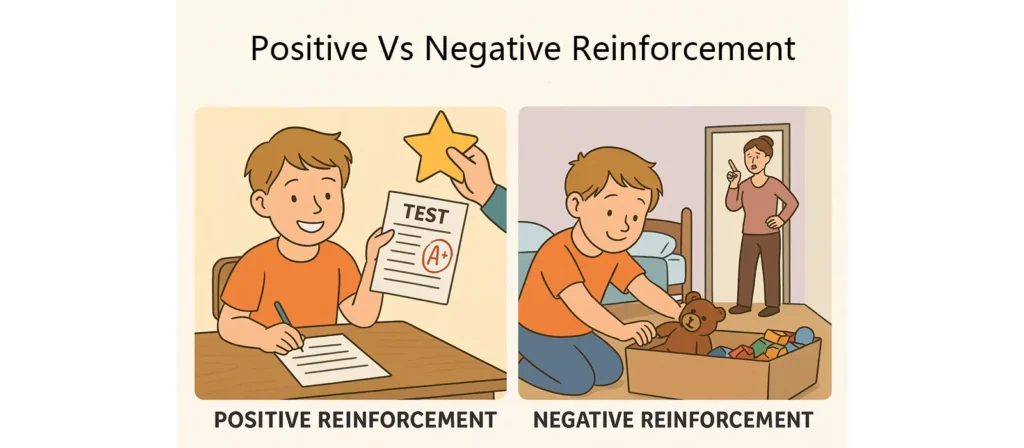
The Purpose of Positive Reinforcement
The primary purpose of positive reinforcement is to encourage repetition of good behavior by creating a pleasant, rewarding experience. It focuses on building a child’s intrinsic motivation by helping them associate positive emotions, like pride, joy, or connection, with their actions. The aim is not just behavior compliance, but also personal growth, confidence, and a positive emotional bond between the adult and the child.
Positive reinforcement also serves to highlight and celebrate progress, rather than just correcting missteps. It’s often used to model desired behaviors, teach new skills, and instill values such as cooperation, kindness, and responsibility in a way that feels natural and uplifting to the child.
The Purpose of Negative Reinforcement
In contrast, the purpose of negative reinforcement is to increase behavior by removing or reducing something undesirable, such as stress, discomfort, or pressure. It focuses less on emotional reward and more on functional relief, teaching the child that their actions can directly and beneficially alter their environment.
This method is often used to promote responsibility, independence, or task completion, especially when the child may not be motivated by rewards alone. It teaches cause and effect through a sense of control: “If I do this, I can stop that from happening.” While still constructive, its emotional tone is more neutral or task-focused compared to the warmth often associated with positive reinforcement.
Type of Stimulus: Positive Reinforcement Vs Negative Reinforcement
One of the most fundamental distinctions between positive reinforcement vs negative reinforcement lies in the type of stimulus each method introduces or removes. Understanding this difference helps clarify how these strategies influence behavior and why they sometimes feel so different in practice, even when they aim for similar outcomes.

Stimulus in Positive Reinforcement
Positive reinforcement works by adding a desirable stimulus immediately after a desired behavior occurs. This could be a tangible reward (like a toy or a sticker), social praise (like a smile or a compliment), or an experience the child enjoys (such as extra playtime or a favorite activity).
The added stimulus is something the child finds pleasant or rewarding. It strengthens the behavior by creating a positive association: “When I do this, something good happens.” Over time, the behavior becomes more frequent because the child anticipates a positive outcome.
Stimulus in Negative Reinforcement
Negative reinforcement, on the other hand, strengthens behavior by removing an unpleasant stimulus after the desired behavior is performed. The stimulus in this case is not something added, but something already present that the child wants to avoid or stop.
By eliminating this discomfort or pressure, the behavior becomes more likely to occur again in the future. The message becomes: “If I do this, something bad goes away.”
Emotional Impact: Positive Reinforcement Vs Negative Reinforcement
Behavioral strategies do more than change actions—they shape emotions. In the comparison of positive reinforcement vs negative reinforcement, one key factor that often gets overlooked is how each method affects a child’s emotional association with learning, rules, and relationships. While both can increase desired behaviors, they create very different emotional experiences.

Emotional Impact of Positive Reinforcement
Positive reinforcement tends to foster feelings of joy, pride, security, and connection. When a child receives praise or a reward for a specific behavior, they’re not just learning what to do—they’re also associating that behavior with a positive emotional outcome. Over time, this helps build confidence, self-esteem, and intrinsic motivation.
Children who regularly experience positive reinforcement often develop a stronger sense of emotional safety. They know that effort and cooperation are noticed and valued. This encourages them to take healthy risks, try new things, and stay engaged without fear of failure or criticism.
These emotional associations strengthen the child’s bond with the adult, turning discipline moments into opportunities for growth rather than conflict.
Emotional Impact of Negative Reinforcement
In contrast, negative reinforcement can evoke more neutral or relief-based emotions, such as stress reduction, anxiety avoidance, or pressure relief. While it can successfully change behavior, the emotional takeaway for the child may be more about escaping discomfort than feeling proud or valued.
This doesn’t mean negative reinforcement is emotionally harmful when used appropriately. It can help a child feel a sense of control and responsibility, especially when they realize they can change their circumstances through their actions. However, if used too often or without care, it may also contribute to a subtle sense of pressure or condition children to act mainly to avoid adverse outcomes.
Children may not always associate the adult with warmth or encouragement in these scenarios, especially if the relief comes after high stress. That’s why negative reinforcement should be balanced with positive strategies to ensure emotional well-being.
Long-Term Impact: Positive Reinforcement Vs Negative Reinforcement
Short-term compliance is easy to achieve, but what really matters is how our behavior strategies influence children in the long run. When comparing positive reinforcement vs negative reinforcement, the difference in long-term outcomes becomes even more pronounced. These strategies don’t just shape habits—they mold character, mindset, and emotional patterns that last well into adulthood.

Long-Term Effects of Positive Reinforcement
Positive reinforcement is well-known for its long-term benefits in both behavior and emotional development. When used consistently and thoughtfully, it helps children internalize positive behaviors—not because they’re told to, but because they understand the value and feel-good results of those behaviors.
Children who grow up with positive reinforcement tend to:
- Develop intrinsic motivation, gradually relying less on external rewards.
- Build self-confidence and a healthy sense of self-worth.
- Form strong relationships with authority figures, rooted in mutual respect and appreciation.
- Learn to self-regulate their actions by recognizing positive patterns and results.
Over time, this approach encourages independence, accountability, and a growth mindset—the belief that effort leads to improvement. It creates a positive behavioral loop: success leads to reinforcement, which leads to more success.
Long-Term Effects of Negative Reinforcement
Negative reinforcement, when applied carefully, can also produce constructive long-term outcomes, especially in developing responsibility and problem-solving skills. It teaches children that their actions have power, particularly in reducing discomfort or resolving issues. However, if misused or over-relied upon, its long-term impact can be less emotionally enriching.
Potential long-term effects of negative reinforcement include:
- Learning to act mainly to avoid discomfort, rather than for internal or emotional satisfaction.
- Becoming compliant but passive, especially if behavior is motivated by the fear of negative stimuli returning.
- Struggling with intrinsic motivation, if most behaviors are framed around “removing pressure” rather than gaining something meaningful.
- Developing avoidance-based coping strategies, such as escaping challenges instead of confronting them.
When used thoughtfully, negative reinforcement can support the development of self-control and adaptability. However, for balanced emotional and behavioral growth, it’s often most effective when paired with positive reinforcement, providing both relief and encouragement.
When to Use: Positive Reinforcement vs Negative Reinforcement
Both positive and negative reinforcement are powerful tools for shaping behavior, but knowing when to use each is just as important as knowing how. The key lies in understanding the child’s needs, the learning context, and the emotional environment.

When to Use Positive Reinforcement
Positive reinforcement is better suited for:
- Introducing a new behavior: Whether it’s learning to say “thank you,” follow a bedtime routine, or complete assignments, rewarding the behavior encourages quick adoption.
- Boosting motivation: If a child is hesitant, lacks confidence, or needs encouragement, positive reinforcement adds emotional and motivational fuel.
- Strengthening emotional connection: Use it to build trust, enhance cooperation, and nurture a supportive relationship between child and adult.
- Creating a proactive بيئة التعلم: In classrooms, it’s ideal for reinforcing participation, kindness, and collaboration among students.
- Encouraging repetition of good behavior: Reinforce positive patterns such as sharing, helping, or staying focused, especially when consistency is your goal.
When to Use Negative Reinforcement
Negative reinforcement is better suited for:
- Reducing resistance or avoidance: If a child avoids tasks or shows reluctance, offering relief from discomfort upon compliance can shift behavior.
- Promoting responsibility and independence: When a child understands that completing a task leads to less oversight or fewer reminders, it encourages self-management.
- Dealing with repetitive behavioral challenges: Use it when the child is motivated to remove an annoying stimulus (e.g., nagging or visual prompts) by doing the right thing.
- Creating functional motivation: For children who respond better to cause-and-effect than praise, removing pressure can help trigger behavior.
- Reinforcing compliance in structured settings: It can help in situations where the child needs to follow rules or routines with less emotional incentive involved.
Positive vs Negative Reinforcement Examples
Understanding the theoretical difference is one thing, but seeing how positive reinforcement vs negative reinforcement works in daily life can make the concepts much more practical. Let’s explore real examples that show how each type of reinforcement helps shape behavior, whether at home, in school, or during everyday interactions with children.
Positive Reinforcement Examples
Positive reinforcement is most effective when it’s specific, timely, and aligned with the child’s interests. Here are some examples of positive reinforcement.
At Home
- A parent praises their child for finishing homework on time: “Great job finishing your work before dinner!”
- A child earns a sticker every time they brush their teeth without being reminded, and five stickers can be traded for a small toy.
- After a child cleans up their toys, they get extra bedtime reading time with mom or dad.

In the Classroom
- A teacher gives a student a “star” for turning in their assignment early, and five stars lead to a classroom privilege like being the line leader.
- A student who consistently helps classmates is recognized during morning announcements, boosting their motivation to continue being helpful.
- Verbal praise like “I love how quietly you’re sitting!” encourages others to model the same behavior.
Negative Reinforcement Examples
Negative reinforcement isn’t about being harsh—it’s about strategically removing something unwanted to guide behavior. Here are some examples of negative reinforcement.
At Home
- A parent stops reminding (nagging) their child to do chores once the child begins completing them independently.
- A child gets to skip doing the dishes because they finished their homework early, removing an unwanted task as a reward for positive behavior.
- Turning off a loud kitchen timer once the child starts practicing piano—relief from the noise encourages the behavior.

In the Classroom
- A student who completes classwork early is excused from a less enjoyable task, such as extra handwriting drills.
- A teacher stops calling on a student to answer questions after they show active participation, reducing the pressure that caused anxiety.
- Removing a behavior chart or reminder list once the student consistently follows rules reinforces independence.
Comparison Table: Positive Reinforcement vs Negative Reinforcement
To help educators and parents better understand the core distinctions between positive reinforcement and negative reinforcement, the table below summarizes the key differences across purpose, mechanism, emotional impact, and use cases.
| وجه | Positive Reinforcement | Negative Reinforcement |
|---|---|---|
| تعريف | Adds a pleasant stimulus after a behavior to increase its frequency | Removes an unpleasant stimulus after a behavior to increase its frequency |
| Goal | Encourage behavior by creating a rewarding outcome | Encourage behavior by offering relief from discomfort or pressure |
| Type of Stimulus | A desirable stimulus is added (e.g., praise, rewards) | Aversive stimulus is removed (e.g., nagging, noise, pressure) |
| Emotional Response | Typically associated with joy, satisfaction, and motivation | Typically associated with relief or reduction of stress |
| أمثلة | Praise, stickers, extra privileges | Ending nagging, removing extra tasks, turning off a timer |
| Timing of Stimulus | A stimulus is introduced after a behavior | A stimulus is withdrawn after behavior |
| When to Use | Teaching new behaviors بناء الثقة Reinforcing positive routines | Reducing anxiety or pressure Teaching coping skills Encouraging calm reactions |
| Long-Term Impact | Builds intrinsic motivation and strengthens emotional connection | Encourages strategic avoidance of discomfort; helpful in managing stress |
| Risk if Misused | Over-reliance may lead to reward dependency | A desirable stimulus is added (e.g., praise, rewards) |
Similarities Between Positive and Negative Reinforcement
While the methods and emotional effects of positive reinforcement vs negative reinforcement may differ, both share several foundational principles in behavioral psychology. Understanding these similarities can help parents and educators see that both strategies are tools, not opposites. When used properly, each can effectively encourage the behaviors you want to see more often.
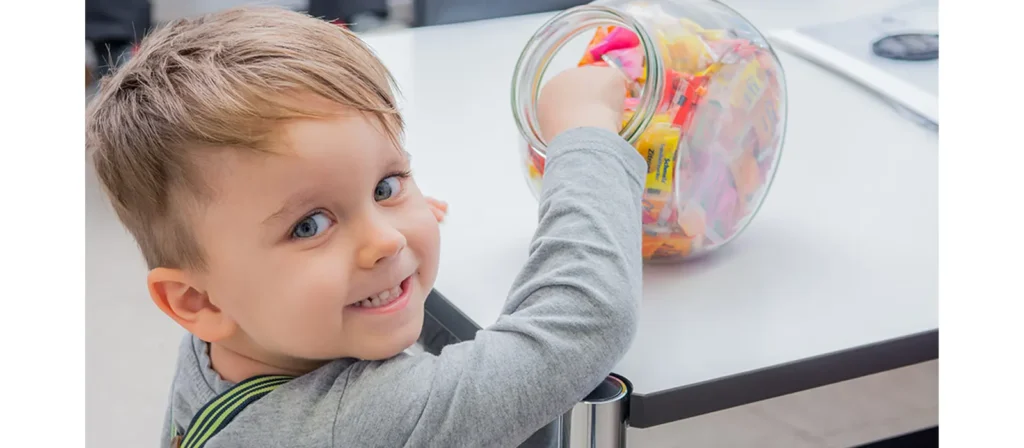
Aim to Increase Desired Behavior
The most fundamental similarity is their goal: both reinforcement types are used to strengthen or increase the likelihood of a desired behavior being repeated. Whether you’re adding a reward or removing discomfort, the child learns that a specific action leads to a better outcome.
Operate on Cause-and-Effect Learning
In both cases, the child makes a connection between behavior and consequence. They recognize a pattern: “When I do this, something positive happens,” or “When I do this, something uncomfortable goes away.” This clarity is key to developing consistent behavior over time.
Require Consistency and Timing
For either method to work, the reinforcement must be delivered immediately and consistently after the desired behavior. Delays or inconsistencies weaken the behavioral connection, making it harder for the child to understand what they’re being reinforced for.
Both Can Be Tailored to the Individual
Just as rewards must be meaningful to the child in positive reinforcement, the unpleasant stimuli in negative reinforcement must also be relevant. What motivates one child might not work for another. Both methods require adults to observe, adapt, and personalize their approach.
Benefit from Clear Expectations
In both strategies, children thrive when expectations are communicated. They need to know what behavior is expected and what will happen when they succeed. This structure makes reinforcement more effective and promotes self-regulation.
More Effective Than Punishment
Compared to punitive strategies that focus on what a child did wrong, both forms of reinforcement focus on encouraging what the child can do right. They build behavior through learning rather than fear, making them far more constructive in the long run.
Positive Reinforcement and Negative Reinforcement in ABA Therapy
Applied Behavior Analysis (ABA) therapy is a structured, evidence-based approach that focuses on improving specific behaviors through reinforcement strategies. Within this framework, the application of positive reinforcement vs negative reinforcement is highly intentional and data-driven, aimed at supporting lasting behavior change, particularly in children with autism or other developmental delays.
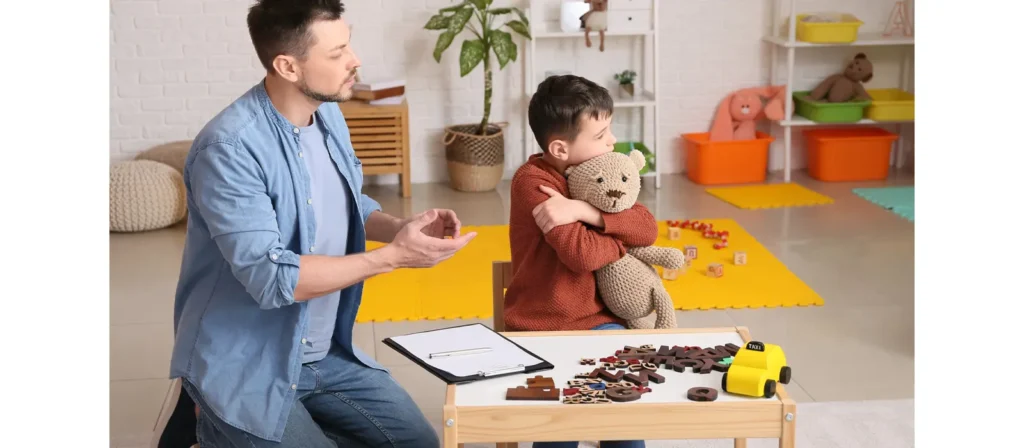
Positive Reinforcement in ABA
Positive reinforcement is the cornerstone of most ABA programs. Therapists use it to teach new skills, increase communication, enhance social behavior, and reduce maladaptive actions. The approach typically involves:
- Identifying a target behavior (e.g., using words instead of gestures)
- Choosing a highly motivating reinforcer (e.g., a favorite toy or snack)
- Delivering that reinforcer immediately after the desired behavior
Over time, positive reinforcement helps children associate productive behavior with rewarding outcomes. It’s particularly effective because it builds a child’s motivation, strengthens trust with the therapist or caregiver, and leads to higher rates of engagement and learning.
Negative Reinforcement in ABA
Negative reinforcement is also used in ABA, but more selectively and with caution. It is applied when the goal is to increase appropriate behavior by removing a non-preferred stimulus. For example:
- A child who completes a task may get a break from a non-preferred activity.
- A loud noise may stop when the child asks appropriately instead of screaming.
In ABA, negative reinforcement is structured to be predictable and constructive, not aversive or punitive. It is used to promote more effective communication or reduce escape-motivated behaviors by teaching the child a better way to avoid discomfort.
The Role of Context in Reinforcement Strategies
No two children are the same, and no two situations are the same. That’s why understanding the role of context is crucial when choosing between positive reinforcement vs negative reinforcement. A strategy that works brilliantly in one environment might fail in another, not because the method is flawed, but because the context wasn’t considered.
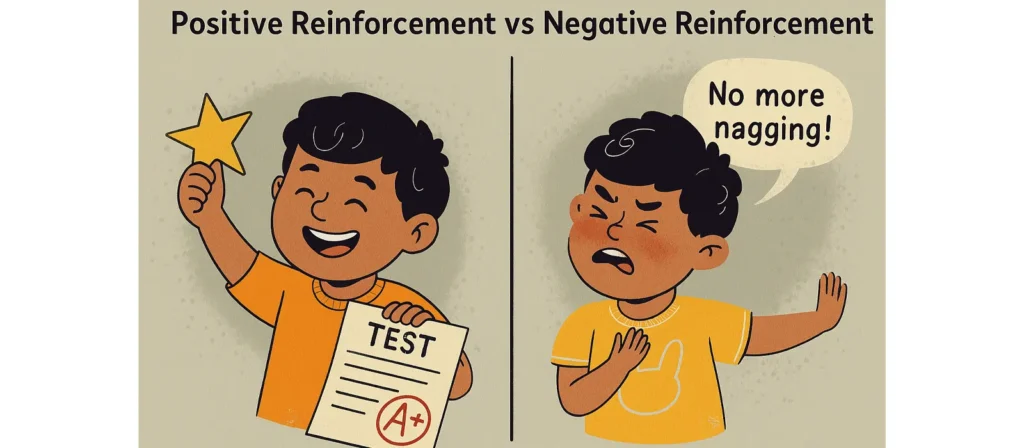
Child’s Developmental Stage
Younger children often respond better to positive reinforcement, especially when the rewards are immediate and tangible. At early مراحل النمو, they may lack the cognitive maturity to understand abstract consequences or delayed gratification. As children grow older and gain more control over their emotions and reasoning, negative reinforcement can be introduced thoughtfully to encourage responsibility and task ownership.
Emotional and Behavioral Needs
Children with anxiety, trauma, or behavioral disorders may interpret certain reinforcements differently. For instance, a child with sensory sensitivity might find common “rewards” (like loud clapping or group attention) overwhelming. In such cases, the context requires customized reinforcement, often using subtle, calming stimuli and minimizing pressure.
Home vs Classroom Environment
In the home, parents might have more flexibility to tailor reinforcement closely to the child’s personality and interests. Positive reinforcement can take emotional or relationship-based forms, like quality time or affectionate praise. In the classroom, however, teachers may need to use reinforcement systems (like token economies or group rewards) that are scalable and consistent across many children.
في classroom settings, negative reinforcement can be effective for managing transitions or prompting cooperation, such as ending a repetitive instruction once the student complies. Still, context matters: it must be used in a way that doesn’t embarrass or stress the child.
Cultural and Social Influences
Cultural expectations and values may also influence reinforcement strategies. In some cultures, external rewards may be seen as motivational; in others, they may be viewed as superficial or even inappropriate. The cultural context affects how children interpret and internalize behavioral cues, and should inform how reinforcement is applied.
Task Type and Goal
Different tasks call for different reinforcement strategies. If the goal is to teach a new skill, such as tying shoelaces or using polite language, positive reinforcement is often more effective. However, if the behavior involves completing an already known task (like cleaning up or following directions), negative reinforcement—removing reminders or extra steps after compliance—can help build independence.
Individual Temperament
Some children are highly responsive to praise and rewards, while others are more motivated by freedom and relief from pressure. A child’s temperament plays a huge role in whether positive or negative reinforcement works better. Observing how the child reacts in different settings provides essential clues for choosing the right approach.
Common Mistakes and Solutions: Positive Reinforcement and Negative Reinforcement
Even with the best intentions, it’s easy to misuse behavior reinforcement strategies—especially when the difference between positive reinforcement vs negative reinforcement isn’t fully understood. Misapplication can lead to confusion, unintended behavior, or even resistance from children. Fortunately, these common mistakes can be addressed with a few key adjustments.

Mistake: Reinforcing the Wrong Behavior
Sometimes adults unintentionally reinforce negative behavior, like giving attention (even in the form of comfort or negotiation) during tantrums. This is common in both types of reinforcement when timing or consistency is off.
حل:
Ensure reinforcement happens only after the desired behavior. Stay calm and neutral during undesirable behavior, and reserve praise, rewards, or relief for the moment the child corrects their action. Clear expectations and timing are everything.
Mistake: Overusing Tangible Rewards
Relying too heavily on stickers, treats, or toys can lead to children expecting a reward every time. This may diminish intrinsic motivation and can backfire when rewards are unavailable.
حل:
Gradually shift from tangible reinforcers to social or natural reinforcers, like praise or privileges. Combine external rewards with meaningful feedback so children feel valued beyond the prize.
Mistake: Using Negative Reinforcement as Punishment
One of the biggest misunderstandings is confusing negative reinforcement with punishment. Removing a favorite activity or using threats may feel like negative reinforcement, but actually function as a punishment.
حل:
Clarify your strategy: Negative reinforcement removes an aversive condition to increase desired behavior. Avoid threats and focus on predictable relief after appropriate behavior, like stopping reminders once a child follows through.
Mistake: Inconsistency Between Adults
In households or classrooms with multiple adults, inconsistency in reinforcement strategies can confuse children. One parent may praise a behavior while another ignores it, or one may remove a task while another insists on it.
حل:
Create a unified reinforcement plan. Communicate clearly with other caregivers or teachers, agree on expected behaviors, and reinforce them in the same way across settings.
Mistake: Ignoring Individual Preferences
Children respond differently to various types of reinforcement. A strategy that works for one child might be completely ineffective for another.
حل:
Observe and engage with the child to discover what motivates them. Let them have a voice in choosing reinforcers and monitor what gets consistent results. Reinforcement should be personalized, not one-size-fits-all.
Mistake: Lack of Follow-Through
Starting a reinforcement system and then dropping it after a few days sends mixed signals. Children may lose interest or become skeptical of consequences.
حل:
Commit to the process. Track behavior, adjust as needed, and give it time to work. Gradual consistency is more effective than brief intensity.
Which is the Best Approach: Positive Reinforcement Vs Negative Reinforcement

While the debate around positive reinforcement vs negative reinforcement often presents them as separate choices, the most effective behavior management strategies often involve a thoughtful blend of both. When used in tandem, these techniques complement each other, providing both motivational encouragement and accountability-driven relief.
For example, a teacher might praise a student for beginning a task on time (positive reinforcement) and then remove a visual reminder chart once the student consistently completes the task independently (negative reinforcement). This dual approach reinforces success with recognition and then sustains it by reducing external pressure, showing the child they’ve earned autonomy.
In a parenting scenario, a child might be rewarded with playtime for completing chores without being asked (positive reinforcement) and simultaneously experience less parental prompting or supervision moving forward (negative reinforcement). The child learns that good behavior brings both joy and freedom.
By combining these strategies:
- Positive reinforcement sparks motivation, connection, and confidence.
- Negative reinforcement promotes independence, responsibility, and task focus.
Together, they offer a flexible, child-centered approach that adapts to different behaviors, personalities, and situations. The key is to apply both with clarity, empathy, and consistency, ensuring that reinforcement not only changes behavior but also builds character and trust over time.
Frequently Asked Questions about Positive and Negative Reinforcement
- Can I use both positive and negative reinforcement with the same child?
Yes. In fact, combining both methods thoughtfully often yields the best results. For example, reward good behavior with praise and reduce supervision once behavior becomes consistent. - Is negative reinforcement the same as punishment?
No. Negative reinforcement increases behavior by removing something unpleasant. Punishment, on the other hand, aims to decrease behavior, either by adding something unpleasant (positive punishment) or removing something pleasant (negative punishment). - When should I avoid using negative reinforcement?
Avoid using negative reinforcement if it creates stress, confusion, or avoidance behaviors. It’s also less effective with very young children who may not understand the cause-and-effect relationship. - Does positive reinforcement always require a reward or treat?
No. While tangible rewards can help, praise, attention, and privileges are also powerful reinforcers. The key is that the stimulus is meaningful to the child. - Can too much positive reinforcement backfire?
Yes. Over-reliance on external rewards can reduce intrinsic motivation. That’s why it’s important to gradually shift toward natural or social reinforcers like praise or responsibility. - How do I know which method is right for my child or student?
Observe how they respond to different motivators. If they seek approval and respond to praise, positive reinforcement is ideal. If they’re more independent or resistant, negative reinforcement might be effective when used carefully. - How to use positive reinforcement effectively in your family?
Start by clearly identifying the behaviors you want to encourage. Use age-appropriate rewards such as praise, extra screen time, or special activities. Be specific, consistent, and timely with reinforcement. Gradually reduce external rewards as the behavior becomes habitual.
خاتمة
Understanding the positive reinforcement vs negative reinforcement equips parents, teachers, and caregivers with powerful tools to guide children’s behavior with empathy and effectiveness. Both approaches serve the same goal to increase desirable behaviors, but they operate through different pathways: one by adding joy, the other by relieving discomfort.
Rather than choosing one over the other, the most impactful strategy often lies in a thoughtful combination of both, tailored to the child’s age, personality, and environment. With clear expectations, consistent application, and emotional sensitivity, reinforcement becomes more than a discipline method—it becomes a path to nurturing growth, trust, and lifelong learning.

